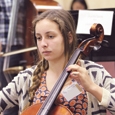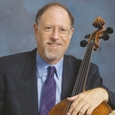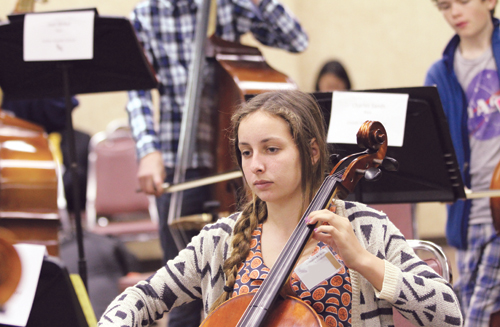
Students who come to study cello with me in college often arrive with fundamental problems of technique that must be addressed. When the problem involves collapsing fingers, bow angle, underlying tension, or weak sound, the difficulties usually can be addressed quickly once the student becomes aware of the problem and knows how to fix it.
Some bad habits, however, are more intractable. The most challenging problems often involve the curvature of the thumb. In pedagogy classes and when talking with teachers, I emphasize the importance of making sure that young cellists are taught to train and position the thumbs correctly. The goal should be to avoid any excess tension in the thumbs and to allow for maximum flexibility. Teachers should be especially vigilant about this in the early stages of a cellist’s development to prevent future problems, including tendonitis.
The Basic Position
In playing the cello the joints of the thumbs of both hands should be bent outward, not squished in. Some teachers refer to this as a bumpy thumb.
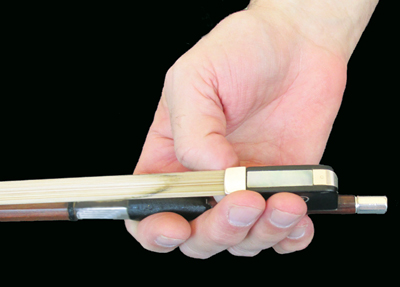
When the thumb is bent inward, it is designed to grab onto something like a hammer. It maximizes the grip and enables power and strength from the arm to manipulate a tool. However, in playing the cello, that kind of force is unneeded – in fact, we need to reduce tension and facilitate the flexibility of the thumb and fingers. A simple test can show the difference between when the thumb is round (bent outward) and when it is straight (bent inward). If you hold your left hand in your right hand with the thumb bent inward, you can squeeze hard and apply pressure. However, if the thumb is curved, you cannot squeeze as hard, which is desirable in playing the cello with both the left hand (for fingering) and the right hand (for bowing). When the thumb is kept round and bent out, we can access the fine motor skills that are necessary for subtle nuances in playing. When the thumb is bent inward, it is inflexible and leads to grabbing the bow, excess tension, and a lack of flexibility. This should be avoided.
The Remarkable Thumb
It turns out that the thumb has more nerve connections to the brain than any other part of the body – except for the tongue. I find this fact interesting because it is these things that separate humankind from the animals: humans have the ability to speak (tongue) and the ability to use tools (thumb). The prehensile, opposable thumb is not only useful for holding things and using tools, but it also is amazingly sensitive and dexterous.
Position of the Thumb
The thumb should be positioned across from or behind the middle finger on both hands.
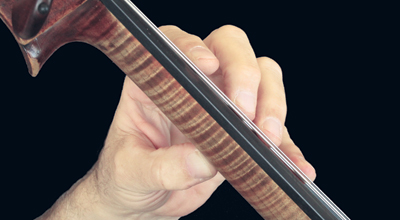
Although some cellists advocate the thumb connecting with the ring finger on the bow, I think it is preferable to use bilateral symmetry with the same thumb-middle finger relationship in both hands, so that one side of the body is similar to the other side.
It is especially important for the left hand thumb to be under the middle finger in extensions. One major problem for many young cellists is that they do not release the thumb before making forward extensions. As a result, when these extensions are made, the hand position becomes distorted, tension increases, and intonation suffers. To avoid this, the thumb should release before making the extension and then move with the middle (second) finger during the extension.
Although it is sometimes difficult for students to train the thumb to use the optimal configuration, it is important for teachers to help them get it right. That means being vigilant, determined, and also creative about how to build good habits. One trick I have found useful is to put scotch tape on the inside of the thumb once it is correctly bent. If the student then feels the tape pulling and stretching, that means the thumb is starting to straighten out, which it should not do, and like Pavlov’s dog they will become conditioned to make the changes.
Students also may be confused about where to place the left hand thumb in neck positions when playing on different strings. I instruct students that as they play on the C string, the thumb should be under the A string; when playing on the A string, the thumb should be under the C string. Thus, the entire arm should move upward when going from the A string to the C string, and the thumb should move around the back of the neck as the player moves across the strings so the whole mechanism works together as a unit.
The Thumb in Thumb Position
The left hand thumb should be well organized in the neck positions before a young cellist starts playing in thumb position – where the thumb is placed on the fingerboard. In thumb position the joints of the left thumb should be the opposite from what was previously described. The joint of the distal phalange (the part of the finger with the nail) should be bent inward, and the joint at the base of the thumb should poke out. I call these joint positions the inny and the outy.
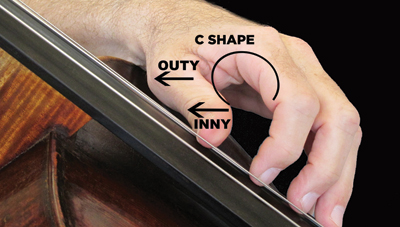
This configuration adds strength and stability to thumb position, and it also prevents the thumb from wobbling as it moves up and down the fingerboard. In establishing the basic thumb position – which creates an octave between the thumb and third finger across two strings (and a perfect fourth on one string) – the knuckles should not be squashed down, and the hand should form a C-shape between the thumb and the first finger as you look down the fingerboard.
There is some disagreement among professional cellists as to whether the thumb should be on one string or across two strings in thumb position. My view is that young students should first learn how to create a stable thumb across two strings in the octave position. Then, in passages in which the second string is not used, students can learn to play in thumb position with the thumb on just one string, which may help to reduce tension. However, passages that require thumb position often employ octaves and double-stops, and in those situations, it is best to have the thumb placed across both strings.
